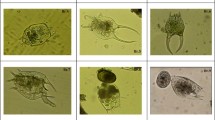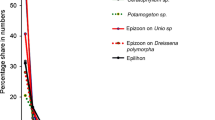Abstract
The distribution of rotifer communities between emergent (Typha angustifolia) and submerged (Chara tomentosa) vegetation and a comparatively open water zone were compared during the spring, summer and autumn seasons at three macrophyte-dominated lakes. This survey identified 107 rotifera species of which 58% of the taxonomical structure was common for the three examined lakes. Stoneworts with a more complicated spatial and morphological structure (having a much longer stem length than the narrow leaf cattail), supported higher rotifer densities. The stem length appeared to be the best predictor of all the macrophyte parameters and pH and chlorophyll a for the chemical variables, for explaining the variation of rotifer densities using the stepwise multiple forward regressions. The distribution of pelagic species did not differ between particular sites, which may have reflected the behavioural requirements of those rotifers. Some of them remained in the open water zone while others seeking an anti-predator refuge, gathered within macrophyte stands during the daytime. Moreover, there were nine Chara-associated species recorded and only one Typha-associated species was noted. The similarity of rotifer communities was most strongly influenced by particular habitat and season.





Similar content being viewed by others
References
Basu, B. K., J. Kalff & B. Pinel-Alloul, 2000. The influence of macrophyte beds on plankton communities and their export from fluvial lakes in the St Lawrence River. Freshwater Biology 45: 373–382.
Bērziņš, B. & B. Pejler, 1987. Rotifer occurrence in relation to pH. Hydrobiologia 147: 107–116.
Canfield, D. E. J., J. V. Shireman, D. E. Colle & W. T. Haller, 1984. Prediction of chlorophyll a concentrations in Florida lakes importance of aquatic macrophytes. Canadian Journal of Fisheries and Aquatic Sciences 41: 497–501.
Celewicz, S., M. Klimko, N. Kuczyńska-Kippen, B. Nagengast, H. Gramowska & T. Sobczyński, 2004. Wpływ zróżnicowanej struktury płatów roślinnych na zespoły planktonowe trzech płytkich jezior Wielkopolski [The influence of the differentiated structure of the macrophyte beds on the plankton communities of three shallow lakes of Wielkopolska]. Badania Fizjograficzne Nad Polską Zachodnią. Seria B – Botanika 53: 95–106.
Celewicz-Gołdyn, S., M. Klimko & N. Kuczyńska-Kippen, submitted. The impact of macrophyte species and season in the habitat choice of phytoplankton in three shallow lakes. Oceanological and Hydrobiological Studies.
Conde-Porcuna, J. M., 2000. Relative importance of competition with Daphnia (Cladocera) and nutrient limitation on Anuraeopsis (Rotifera) population dynamics in a laboratory study. Freshwater Biology 44: 423–430.
Crowder, L. B., E. W. Mc Collum & T. H. Martin, 1998. Changing perspectives on food web interactions in lake littoral zones. In Jeppesen E., M. Søndergaard & K. Christoffersen (eds), The Structuring Role of Submerged Macrophytes in Lakes. Springer, Berlin, Heidelberg, New York, 240–249.
Degans, H. & L. De Meester, 2002. Top–down control of natural phyto- and bacterioplankton prey communities by Daphnia magna and by the natural zooplankton community of the hypertrophic Lake Blankaart. Hydrobiologia 479: 39–49.
Diehl, S., 1992. Fish predation and benthic community structure: The role of omnivory and habitat complexity. Ecology 73: 1646–1661.
Diehl, S. & R. Kornijów, 1998. Influence of submerged macrophytes on trophic interactions among fish and macroinvertebrates. In Jeppesen E., M. Søndergaard, & K. Christoffersen (eds.), The Structuring Role of Submerged Macrophytes in Lakes. Springer, Berlin, 24–46.
Duggan, I. C., 2001. The ecology of periphytic rotifers. Hydrobiologia 446/447: 139–148.
Irfanullah, H. & B. Moss, 2005. Effects of pH and predation by Chaoborus larvae on the plankton of a shallow and acidic forest lake. Freshwater Biology 50: 1913–1926.
Jones, J. I., B. Moss, J. W. Eaton & J. O. Young, 2000. Do submerged aquatic plants influence periphyton community composition for the benefit of invertebrate mutualists? Freshwater Biology 43: 591–604.
Kairesalo, T., I. Tátrai & E. Luokkanen, 1998. Impacts of waterweed (Elodea canadensis Michx) on fish-plankton interactions in the lake littoral. Verhandlung Internationale Vereinigung für theoretische und angewande Limnologie 26: 1846–1851.
Kobayashi, T., 1997. Associations between environmental variables and zooplankton body masses in a regulated Australian river. Marine and Freshwater Research 48(6): 523–529.
Koste, W, 1978. Rotatoria. Die Rädertiere Mitteleuropas. Gebrüder Borntraeger, Berlin, Stuttgart.
Krebs, Ch. J., 2001. Ecology. The Experimental Analysis of Distribution and Abundance. Wydawnictwo Naukowe PWN, Warszawa, 734 pp.
Kuczyńska-Kippen, N., 2006. Zooplankton structure in architecturally differentiated macrophyte habitats of shallow lakes in Wielkopolska Region, Poland. Oceanological and Hydrobiological Studies XXXV/2: 179–191.
Kuczyńska-Kippen, N., B. Messyasz, B. Nagengast, S. Celewicz & M. Klimko, 2005. Comparative study of periphyton communities on the reed complex and Chara tomentosa in three shallow lakes of Wielkopolska area, Poland. Biologia Bratislava 60(4): 1–7.
Kuczyńska-Kippen, N. M. & B. Nagengast, 2006. The influence of the spatial structure of hydromacrophytes and differentiating habitat on the structure of rotifer and cladoceran communities. Hydrobiologia 559: 203–212.
Lillie, R. A. & J. Budd, 1992. Habitat architecture of Myriophyllum spicatum L. as an index to habitat quality for fish and macroinvertebrates. Journal of Freshwater Ecology 7: 113–125.
Lodge, D. M., 1991. Herbivory on freshwater marophytes. Aquatic Botany 41: 195–224.
Margalef, R., 1957. Information theory in ecology. General Systems 3: 36–71.
Messyasz, B. & N. Kuczyńska-Kippen, 2006. Periphytic algal communities: A comparison of Typha angustifolia L. and Chara tomentosa L. beds in three shallow lakes (West Poland). Polish Journal of Ecology 54(1): 13–24.
Pace, M. L., J. J. Cole & S. R. Carpenter, 1998. Trophic cascades and compensation: Differential responses of microzooplankton in whole-lake experiments. Ecology 79(1): 138–152.
Persson, L. & P. Eklov, 1995. Prey refuges affecting interactions between piscivorous perch and juvenile perch and roach. Ecology 76: 70–81.
Petr, T., 2000. Interactions between fish and aquatic macrophytes in inland waters. A review. FAO Fisheries Technical Papers, 185 pp.
Radwan, S., I. Bielańska-Grajner & J. Ejsmont-Karabin, 2004. Wrotki Rotifera. Fauna słodkowodna Polski. [Rotifers Rotifera. Freshwater fauna of Poland]. Oficyna Wydawnicza Tercja, 447 pp.
Raffaelli, D., S. Hall, C. Emes & B. Manly, 2000. Constraints on body size distributions: An experimental approach using a small-scale system. Oecologia 122: 389–398.
Savino, J. F. & R. A. Stein, 1992. Bluegill growth as modified by plant density: An exploration of underlying mechanisms. Oecologia 89: 153–160.
Schriver, P. J., E. Bøgestrand, E. Jeppesen & M. Søndergaard, 1995. Impact of submerged macrophytes on fish-zooplankton-phytoplankton interactions: Large scale enclosure experiments in a shallow eutrophic lake. Freshwater Biology 33: 255–270.
Scheffer, M., 2001. Ecology of Shallow Lakes. Kluwer Academic Publishers. Dordrecht, 357 pp.
Sokal, R. R. & F. J. Rohlf, 1995. Biometry. The Principles and Practice of Statistics and Biological Research. W.H. Freeman and Company. New York.
Standard Methods for Examination of Water and Wastwater 1992. American Public Health Association, New York, 1137 pp.
Sterner, R. W. & K. L. Schulz, 1998. Zooplankton nutrition: Recent progress and a reality check. Aquatic Ecology 32: 261–279.
Strickland, J. D. & T. R. Parsons, 1972. A Practical Handbook of Seawater Analysis, 2nd edn. Bulletin of the Fisheries Research Board of Canada, 167 pp.
Tessier, C., A. Cattaneo, B. Pinel-Alloul & G. Galanti, 2004. Biomass, composition and size structure of invertebrate communities associated to different types of aquatic vegetation during summer in Lago di Canada (Italy). Journal of Limnology 63(2): 190–198.
Van de Meutter, F., R. Stoks & L. De Meester, 2005. Spatial avoidance of littoral and pelagic invertebrate predators by Daphnia. Oecologia 142: 489–499.
Van den Berg, J., H. Coops, R. Noordhuis, J. van Schie & J. Simons, 1997. Macroinvertebrate communities in relation to submerged vegetation in two Chara-dominated lakes. Hydrobiologia 342/343: 143–150.
Van Dijk, G. M., 1993. Dynamics and attenuation characteristics of periphyton upon artificial substratum under various light conditions and some additional observations on periphyton upon Potamogeton pectinatus. Hydrobiologia 252: 143–161.
Warfe, D. M. & L. A. Barmuta, 2004. Habitat structural complexity madiates the foraging success of multiple predator species. Oecologia 141: 171–178.
Wetzel, R. G., 2001. Limnology: Lake and River Ecosystem—Part 19: Land-water interface: Attached Microorganisms, Littoral Algae and Zooplankton. Academic Press, San Diego, 1006 pp.
Author information
Authors and Affiliations
Corresponding author
Additional information
Guest editors: S. S. S. Sarma, R. D. Gulati, R. L. Wallace, S. Nandini, H. J. Dumont & R. Rico-Martínez
Advances in Rotifer Research
Rights and permissions
About this article
Cite this article
Kuczyńska-Kippen, N. Habitat choice in rotifera communities of three shallow lakes: impact of macrophyte substratum and season. Hydrobiologia 593, 27–37 (2007). https://doi.org/10.1007/s10750-007-9073-6
Published:
Issue Date:
DOI: https://doi.org/10.1007/s10750-007-9073-6




